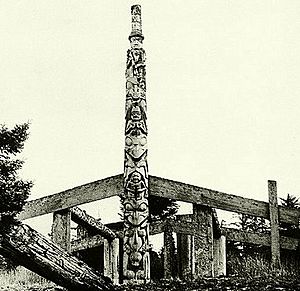Kayung totem pole facts for kids
Quick facts for kids The Kayung totem pole in the Great Court of the British Museum |
|
|---|---|

Being installed in the Great Court
|
|
| Material | Cedar |
| Height | 12 metres (39 ft) |
| Created | c. 1850 in Canada |
| Present location | The Great Court of the British Museum |
| Identification | Am1903,0314.1 |
The Kayung totem pole is a very tall, 12-meter (about 40-foot) totem pole. It was made by the Haida people, who are an Indigenous group from Canada. This amazing pole was carved around 1850 in a village called Kayung on Graham Island in British Columbia. Today, you can see it on display at the British Museum in London, England, where it has been a main attraction in the Great Court since 2007.
Contents
The Kayung Totem Pole's Journey
The British Museum got this totem pole in 1903. At that time, the pole was about 50 years old. Totem poles were created as special signs, like family crests or important stories for a community. However, the tradition of making them was becoming less common.
The museum bought the pole from a person named Charles Frederick Newcombe. He sold many totem poles to museums in Europe. The museum was sure this pole was from Kayung because they already had a small model of it. They also had two photos showing the pole in its original village.
Before it came to the museum, the pole stood in a village called Kayung. This village was on Graham Island in an area now known as Haida Gwaii in British Columbia. Kayung was a very important Haida village before Europeans arrived. Sadly, many people in the village became sick from diseases like smallpox in the late 1800s. Because of this, the chief, Henry Wiah, encouraged the remaining people to move to a nearby village called Masset.
The village of Kayung was being left empty around 1884. A photographer named Richard Maynard took pictures of it then. He counted 14 houses in the village.
What the Kayung Totem Pole Looks Like
The Kayung totem pole is 12 meters (about 40 feet) tall. Because it is so big, for a long time it was kept in a stairwell at the British Museum. This was the only place tall enough to hold it! In 2007, a new glass roof was built over the museum's Great Court. This finally made it possible to stand the pole upright there for everyone to see.
Over the years, the weather has worn away any paint that was on the pole. But we know what the carvings mean. Chief Wiah told the stories to Charles F. Newcombe, and these stories were written down in 1903. Another totem pole at the museum also helps confirm these stories. That pole came with a model of a First Nations longhouse and was almost exactly like the Kayung pole.
The figure at the very top of the Kayung pole shows a character called Yetl. The pole also has other designs that are important Haida family crests.
In 2007, when the pole was put up in the Great Court, Haida guests came to the museum. They shared the story carved into the pole. It is a story about a man who cleverly outsmarts his mean mother-in-law.
The Kayung Pole's Stories
There are two main stories linked to the Kayung totem pole.
Yetl and the Lost Beak
The first story was told to Charles Newcombe by Chief Wiah.
In a certain village, whenever people went fishing, they would lose their hooks and the fish they caught. This was happening because of Yetl. Yetl was a powerful being who had created all life and its many different forms. Yetl usually looked like a raven. But this time, he pretended to be a friend who could swim under the sea. Yetl was very hungry and was secretly eating the villagers' fish.
The villagers decided to make new hooks from wood and bone. These hooks had two sharp points. They put a piece of devil fish on one of these new hooks. Something big took the bait! After a long struggle, a fisherman and his friends finally pulled it to the surface. But as they pulled hard, the fishing line suddenly went loose. When they reeled it in, they found only a small, strange item on the end. They did not know it, but they had caught Yetl and pulled off his raven's beak!
To get his beak back and find food, Yetl changed into a human. The villagers welcomed him as a guest. He hid his wound by only showing the top half of his face. Even though he could only speak nonsense, he managed to convince the villagers to give him back his beak. Later, Yetl returned to the village again, disguised as a chief. He was welcomed as a guest once more. The figure at the top of the pole shows Yetl when he appeared as a chief and sat down to eat with the villagers.
The Young Man and the Whale
The second story is about a young man who loved to gamble with short sticks. He lost all his money. But he was able to marry the daughter of a rich man. Soon, he lost all his new money too. One night, he was eating dried halibut. It made a tearing sound as he ate it. His wife's mother made fun of him. She said his greed made it sound like he was tearing his own body, not the fish.
The young man was so upset that he went to sleep hungry. The next morning, he chewed so much of a special plant that he gained Shaman powers. A Shaman is a person believed to have special powers to heal or talk to spirits. The young man used his new powers to call a whale. He cut a hole in its side and went inside the whale.
His mother, who also had shaman powers, dreamed that the whale had arrived. She dressed as a shaman and convinced the villagers to drink warm seawater. Then, they all went with her to find the whale. She had some villagers beat drums while she danced on the stranded whale, shaking her shaman's rattles. When the singing and dancing finished, they cut open the whale. Inside, they found the young man! His mother felt bad about how she had treated him before. This story was then told from one generation to the next.
See also
 In Spanish: Tótem Kayung para niños
In Spanish: Tótem Kayung para niños



